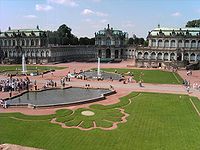
Schwerin Castle is a 19th-century Schloss built in the historicist style located in the city of Schwerin, the capital of Mecklenburg-Vorpommern state, Germany. It is situated on an island in the city's main lake, Lake Schwerin.

A manor house was historically the main residence of the lord of the manor. The house formed the administrative centre of a manor in the European feudal system; within its great hall were usually held the lord's manorial courts, communal meals with manorial tenants and great banquets. The term is today loosely applied to various English country houses, mostly at the smaller end of the spectrum, sometimes dating from the Late Middle Ages, which currently or formerly house the landed gentry.
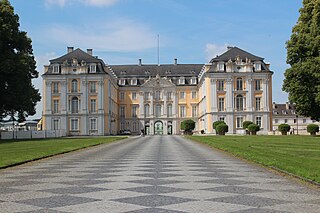
The Augustusburg and Falkenlust Palaces form a historical building complex in Brühl, North Rhine-Westphalia, Germany. The buildings are connected by the spacious gardens and trees of the Schlosspark. Built in the early 18th century, the palaces and adjoining gardens are considered masterpieces of early rococo architecture and have been listed as a UNESCO cultural World Heritage Site since 1984. Augustusburg Palace and its parks also serve as a venue for the Brühl Palace Concerts.

Gottorf Castle is a castle and estate in the city of Schleswig, Schleswig-Holstein, Germany. It is one of the most important secular buildings in Schleswig-Holstein, and has been rebuilt and expanded several times in its over eight hundred years of history, changing from a medieval castle to a Renaissance fortress to a Baroque palace.
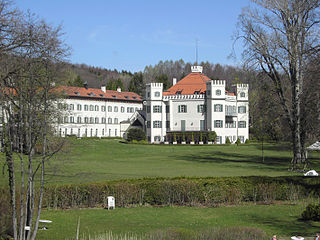
Possenhofen Castle is a condominium complex and former palace located in Possenhofen on the western shore of Lake Starnberg in Bavaria, Germany. It is best known as being the childhood summer residence of Empress Elisabeth of Austria.

Laxenburg castles are imperial palaces and castles outside Vienna, in the town of Laxenburg owned in equal parts by Vienna and Lower Austria. The castles became a Habsburg possession in 1333 and formerly served as a summer retreat, along with Schönbrunn palace, for the imperial Habsburg dynasty. Blauer Hof Palace was the birthplace of some members of the royal family, including Crown Prince Rudolf. Another castle nearby is named Franzensburg castle.

Schloss Favorite is a Baroque maison de plaisance and hunting lodge in Ludwigsburg, Germany, which was used as a summer residence and hunting lodge. It is located on a rise, directly north of Ludwigsburg Palace to which it is connected via an avenue.

Schloss Rastatt, also known as Residenzschloss Rastatt, is a Baroque schloss in Rastatt, Germany. The palace and the garden were built between 1700 and 1707 by the Italian architect Domenico Egidio Rossi for Margrave Louis William of Baden-Baden. Visitors can tour the restored Baroque interior and gardens.
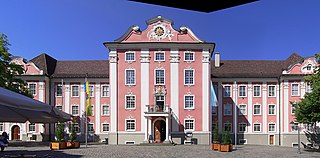
The Neues Schloss Meersburg is located in Meersburg near Lake Constance in Baden-Württemberg, Germany. From its construction in 1750 until the bishopric was dissolved in 1803 it was the seat of the Prince-Bishop of Constance.

Schloss, formerly written Schloß, is the German term for a building similar to a château, palace, or manor house.

Schloss Oldenburg is a schloss, or palace, in the city of Oldenburg in the present-day state of Lower Saxony, Germany. The first castle on the site was built around 1100 and became the ancestral home of the House of Oldenburg. The present building served as residence to the counts (1667–1785), dukes (1785–1815) and grand dukes (1815–1918) of Oldenburg.

In Renaissance and Early Modern German architecture, a Lustschloss is a country house, château, or palace which served the private pleasure of its owner, and was seasonally inhabited as a respite from court ceremonies and state duties. In France, the Château de Madrid in the Bois de Boulogne, easily reached from Paris, arguably set an example, and Louis XIV similarly holidayed annually from the Palace of Versailles to his nearby Château de Marly, and more frequently used his Grand Trianon, to which the Petit Trianon was added in the following century.

Albrechtsberg Palace or Albrechtsberg Castle is a Neoclassical stately home above the Elbe river in the Loschwitz district of Dresden. It was erected in 1854 according to plans designed by the Prussian court and landscaping architect Adolf Lohse (1807–1867) at the behest of Prince Albert, younger brother of the Prussian king Frederick William IV.

Pillnitz Palace is a restored Baroque castle at the eastern end of the city of Dresden in the German state of Saxony. It is located on the right bank of the River Elbe in the former village of Pillnitz. It was the summer residence of many electors and kings of Saxony; it is also known for the Declaration of Pillnitz in 1791.
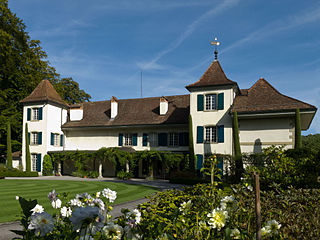
Bremgarten Castle is a castle in the municipality of Bremgarten of the canton of Bern in Switzerland. It is a Swiss heritage site of national significance.

Schloss Warthausen is a schloss near the town of Warthausen in Germany. It has been home to several famous historical personages, including authors Christoph Martin Wieland and Sophie von La Roche, and painter Johann Heinrich Tischbein. It was the traditional home of the Counts of Stadion-Warthausen. It is the subject of an article, The Gardens at Schloss Warthausen and Their Place in German Literature.
This page is based on this
Wikipedia article Text is available under the
CC BY-SA 4.0 license; additional terms may apply.
Images, videos and audio are available under their respective licenses.












